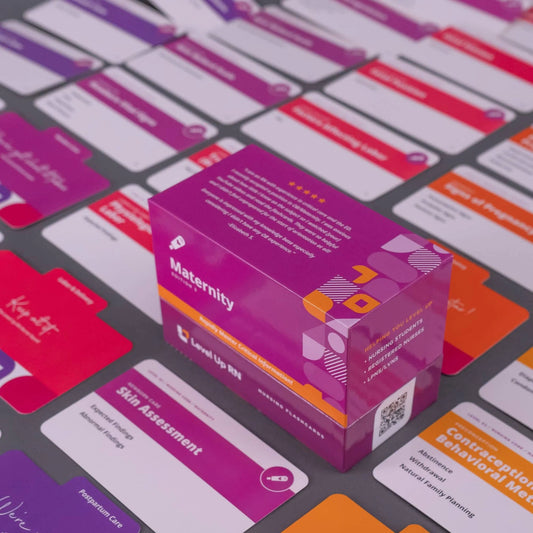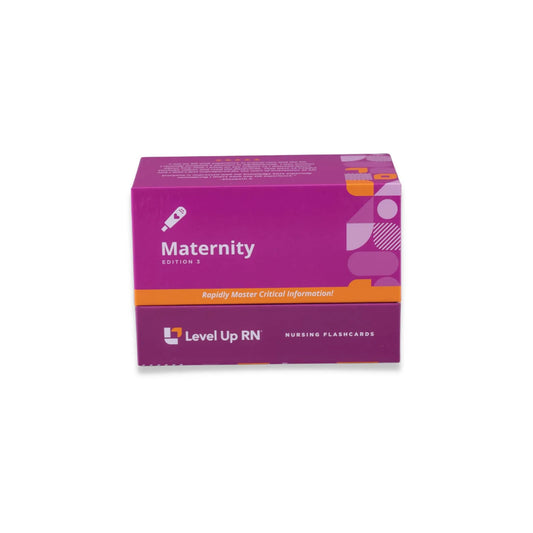Maternity Nursing - Flashcards
This article concludes our discussion of complications of pregnancy, including hypertensive disorders, group B strep, and amniotic fluid disorders. The Maternity Nursing series follows along with our Maternity Nursing Flashcards, which are intended to help RN and PN nursing students study for nursing school exams, including the ATI, HESI, and NCLEX.
Hypertensive disorders in pregnancy
Hypertensive disorders can cause systemic vasoconstriction (narrowing of blood vessels) and vasospasm (another condition where the blood vessels narrow) in the patient, leading to impaired circulation to the organs (including the placenta) during pregnancy, which may affect the fetus. For example, hypertension in the patient might lead to placental insufficiency, as well as causing additional problems for the patient and their baby.
Among the types of hypertensive disorders are gestational hypertension, preeclampsia, eclampsia, and HELLP syndrome.
Gestational hypertension
Gestational hypertension is a form of hypertension. Indications include a blood pressure greater than 140/90 after 20 weeks of gestation. Note that in diagnosing gestational hypertension, a single blood pressure reading is not diagnostic — it is necessary to take at least two blood pressure readings four hours apart from one another to confirm this diagnosis. Also: a urine test will indicate that there is no protein in the urine.
Preeclampsia
Preeclampsia is a very serious condition and if untreated, can progress to eclampsia. Preeclampsia can be mild or severe.
Mild preeclampsia
A patient with mild preeclampsia will have a blood pressure over 140/90. A urinalysis will show they have protein in their urine (proteinuria), measured at 1+.
Remember that in a urinalysis test, protein is measured as none, trace, 1+, 2+, 3+, 4+. An elevated blood pressure and 1+ protein in the patient's urine indicates mild preeclampsia.
Severe preeclampsia
A patient with severe preeclampsia will be experiencing even more hypertension. Their blood pressure will be over 160/100. And they will have proteinuria at or above 3+.
Another symptom of severe preeclampsia is prolonged, severe headache. Note that while headache is very common in pregnancy, a headache that is severe and won’t go away needs to be investigated.
Additional symptoms include blurred vision, which is not normal in pregnancy. A patient who reports blurred vision or that they're seeing spots or floaters in their vision is an indication they might have preeclampsia.
Other signs and symptoms of severe preeclampsia are epigastric pain (pain above that belly button), thrombocytopenia (decreased platelets), impaired liver function (increased AST, ALT), impaired kidney function (an increase in creatinine), edema (swelling), and hyperreflexia (over-responsive reflexes, which can result in twitching).
You can learn more about the lab values for liver enzymes and more with our Lab Values Study Guide & Flashcard Index is a list of lab values covered in our Lab Values Flashcards for nursing students and can be used as an easy reference guide.
Eclampsia
Eclampsia may follow mild or severe preeclampsia and, in terms of symptoms, includes the onset of seizures.
For a patient who is preeclamptic and in the hospital, it is important to institute seizure protocols, in the event a preeclamptic patient's condition worsens and they start to seize.
HELLP
HELLP is a life-threatening liver disorder thought to be a type of severe preeclampsia, although HELLP syndrome may occur without warning and is not always associated with preeclampsia.
H-E-L-L-P, is a mnemonic that stands for “Hemolysis, Elevated Liver enzymes and Low Platelets.” As noted, this condition has a high risk of maternal death.
The patient is likely going to complain of epigastric or right upper quadrant pain because of the involvement of the liver. Their labs will show elevated liver enzymes, (AST, ALT), and they will have low platelets (thrombocytopenia).
You can learn more about the lab values for liver enzymes and more with our Lab Values Study Guide & Flashcard Index, a list of lab values covered in our Lab Values Flashcards for nursing students and can be used as an easy reference guide.
Treatment
Treatment for hypertensive disorders will include administering antihypertensive medications, such as hydralazine, labetalol, methyldopa, and nifedipine.
Remember that ACE (angiotensin-converting enzyme) inhibitors and ARBs (angiotensin receptor blockers) are classes of drugs that are contraindicated during pregnancy. So you should not be administering those medications to a patient during pregnancy. Hydralazine and labetalol are usually the go-to drugs and will help lower the patient's blood pressure.
Treatment for hypertension will likely also include magnesium, an important electrolyte for nerve and muscle function, which may calm the patient's symptoms — recall that magnesium sulfate is an anticonvulsant.
Nursing care
It is possible to have too much magnesium, which may result in adverse conditions that affect the patient's deep tendon reflexes, including the reflex that allows them to breathe. So for a patient receiving magnesium, it is important to assess their respiratory status and quality, frequently. Also note if their urine output is dropping — signs of magnesium toxicity. In the event of magnesium toxicity, administer calcium gluconate.
Patient teaching
A patient experiencing hypertensive disorders should alter their diet. They should avoid high-sodium foods and limit caffeine. It's also important to maintain a quiet environment to prevent seizures. These patients may also need to be on bed rest, possibly in a hospital where they may be treated.
Group B streptococcus Beta-hemolytic (GBS)
Group B streptococcus (GBS) is Beta-hemolytic. It is a bacterial infection that can be passed to a child during the birthing process and cause life-threatening infections in a newborn.
GBS is a type of bacteria that — for some people — exists on their skin as a normal skin flora, causing them no problem. But the bacteria can be passed to the child during the birthing process and harm the newborn.
Diagnostics
To diagnose group B streptococcus, a pregnant patient is tested between 35 and 37 weeks of gestation. Testing is performed with a vaginal and rectal swab — basically, a swab of the whole perineum to see if the patient is a colonizer for group B strep.
Treatment
For a patient diagnosed with GBS, they will be treated with intrapartum antibiotics (e.g., ampicillin or penicillin G) during birth.
Additionally, a pregnant patient about to give birth may be treated if they have previously delivered an infant having been diagnosed with GBS. Antibiotics will also be administered in the event of an unknown GBS status, if the patient has a fever at or above 38°C (100.4°F), if there has been a prolonged rupture of membranes (more than 18 hours), or during preterm labor (less than 37 weeks).
Complications
A mother who has group B strep could experience complications after childbirth, including sepsis and chorioamnionitis (an infection of the placenta and the amniotic fluid).
The baby could develop meningitis, pneumonia, and sepsis, in the event of coming into contact with GBS, which makes testing of the birthing mother so important.
Amniotic Fluid Abnormalities
Amniotic fluid abnormalities include polyhydramnios, oligohydramnios, and chorioamnionitis.
Polyhydramnios
Polyhydramnios means excess amniotic fluid volume (“poly,” meaning many, “hydramnios,” meaning amniotic fluid).
Risk factors for polyhydramnios
The risk factors for polyhydramnios include gestational diabetes or where there are fetal congenital abnormalities.
Treatment of polyhydramnios
Amniocentesis is a diagnostic procedure that can also be a therapeutic procedure — removing amniotic fluid from the uterus via amniocentesis is a means to treat polyhydramnios.
Oligohydramnios
Oligohydramnios is the opposite of polyhydramnios, that is a decreased volume of amniotic fluid (“oligo” means “little” or “few”).
Risk factors for oligohydramnios
The risk factors for oligohydramnios include the premature rupture of membranes (PROM), as well as uteroplacental insufficiency (decreased blood flow to the baby, which can lead to fetal hypoxia) — if the placenta isn't getting enough blood flow, we might notice decreased amniotic fluid.
Fetal genitourinary abnormalities are another risk factor. These are abnormalities of the fetus’ genital urinary tract. Remember that babies practice breathing in the womb, which means they swallow amniotic fluid. This allows their kidneys to start processing that fluid as urine, which they pee back out. But if the baby has a genitourinary malformation or congenital defect, this may not happen, which could cause oligohydramnios.
Treatment of oligohydramnios
Treatment for oligohydramnios includes amnioinfusion (infusion of normal saline or LR (lactated Ringer's solution, also known as sodium lactate solution) into the amniotic cavity) for umbilical cord compression.
Chorioamnionitis
Chorioamnionitis, as noted above, is an infection or inflammation of the amniotic sac (of the chorion and the amnion, hence chorioamnionitis).
Risk factors for chorioamnionitis
Chorioamnionitis is common in a patient who has had a genital urinary infection (e.g, a UTI) or if they had some other sort of infection affecting their reproductive or urinary tract. This infection will cause maternal fever, elevated white blood cells, uterine pain, and a malodorous vaginal discharge.
Treatment of chorioamnionitis
Antibiotics are the go-to treatment for chorioamnionitis.


